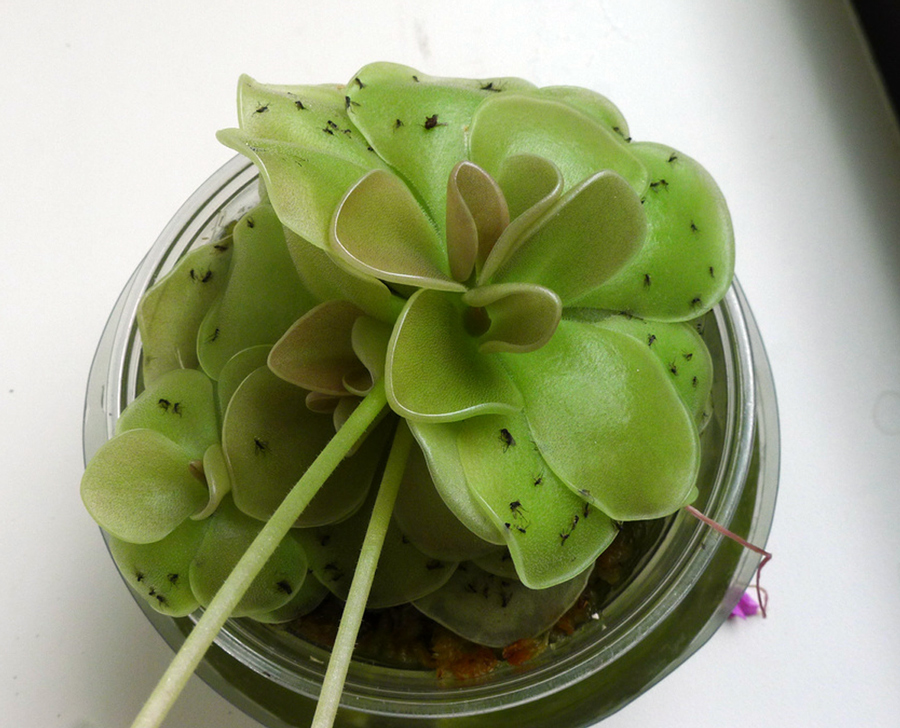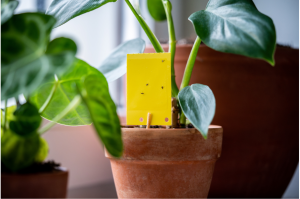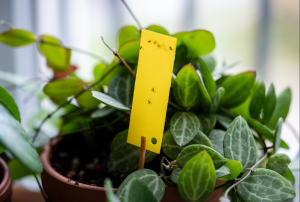House plants bring life and freshness into our homes, transforming dull spaces into vibrant green sanctuaries. But let’s talk about a not-so-joyful aspect of plant parenthood: fungus gnats. Those pesky little insects can turn our indoor oasis into a buzzing nuisance faster than you can say, “Hey, where did all these tiny flies come from?”
Picture this: you’re peacefully admiring your thriving green friends when suddenly, you notice tiny, winged intruders darting around your beloved plants. It’s like a miniature airshow, except you didn’t buy tickets and you certainly didn’t invite these uninvited guests!

You’re not seeing spots, you’re seeing fungus gnats on your plants.
Of the six pests (spider mites, mealy bugs, thrip, scale, white fly and fungus gnats) Good Earth Plants deals with, fungus gnats are the biggest pain for plant parents in San Diego. You may not see the other bugs on your plants, but fungus gnats are literally in your face – they’re attracted to the carbon dioxide we exhale.
Fungus gnats are found in damp sewer areas, household drains, and wet plant soil. The larvae are only one-hundredth of an inch long and nearly impossible to see, until they grow into adult gnats and fly out of the plant soil into your face. They feed on plant roots, leaves on the soil, and decaying plant materials. They grow in about 10 days and will reproduce year-round on your indoor plants!
All that tender care, including watering your house plants, causes this problem. If the soil of your houseplants is consistently damp, the fungus gnats will love living at your house. Another cause is the growing media of houseplants. Many types of potting mixes contain materials that retain moisture, and anything that encourages moisture encourages fungus gnats. This is why Good Earth Plant Company buys from nurseries that pre-treat the soil to eliminate possible infestations.
But fear not, fellow plant enthusiasts, for all hope is not lost! Here at Good Earth Plant Company, we understand the struggle. We know that fungus gnats can be as irritating, that’s why we’re here to rescue you from this buzzing nightmare with the following expert recommendations.
If you’re one of our clients, and are struggling with fungus gnats, give us a call and we can create an action plan for tackling these annoying pests! After 30+ years of taking care of plants, we know how to handle these tiny beasts!

Yellow sticky traps are one good weapon in the fight against fungus gnats
Here’s what you can do to get rid of fungus gnats:
- First, start letting your houseplants dry out between waterings. The top 1-2 inches should be completely dry. This is one reason why sub-irrigation works well.
- Be sure to remove any dropped or decaying plant materials (leaves and roots) which provide food sources for fungus gnat larvae. If you want to check and see if you have them, put several raw potato slices on the top of the soil. After a few days, take a look at the bottom. Do they look chewed? You have fungus gnat larvae in your plants.
- To control the larvae, you can put a quarter to a half inch of horticultural sand (NOT beach sand) or diatomaceous earth on top of the soil. When you water, it will dry more quickly and confuse the fungus gnats that the plant is dry and not a good place to lay any eggs. And if they crawl across the diatomaceous earth, they are literally sliced to death.
- Every other time you water, add one tablespoon of liquid dish soap and one teaspoon of white vinegar to the water. Eventually it will kill the fungus gnat larvae.
- If you want to speed up the process, you can take the plant out of the pot, remove as much of the soil as possible without damaging the plant, then repot it. Put all the old soil into a sealed bag and throw it away. You can’t use it anywhere else or you will just spread the problem.

Fungus gnat can be tricky to get rid of, but here at Good Earth we know how to handle this pest!
- Buy some sticky insect traps, or make your own. Use pieces of bright yellow colored cardboard and spread Vaseline all over them. Put them above your plants horizontally for the best results. Or use the kind of card holder that comes with a plant from your florist. Put the sticky trap in the card holder and stick it into your plant.
- Some home gardeners swear by pouring three percent hydrogen peroxide directly into your plant soil. If you have an especially precious or delicate plant, I wouldn’t recommend this as your first choice.
If fungus gnats repeatedly infest your plants, especially in your office, it may be a serious challenge to completely get rid of them yourself. We’ve seen a case where the gnats were coming in through the ventilation system from another office!
If you are the one trying to take care of your office plants, you may want to consider bringing in an interior plant company like Good Earth Plants. We enrich people’s lives with plants – it’s our mission every day.
Here at Good Earth Plants we only use plants from quality growers and our technicians are experts in preventing and getting rid of fungus gnats. If one of our plants gets infested (which doesn’t happen all that often), we immediately remove it, so fungus gnats don’t get into the rest of your plants.
If you’re one of our clients, our horticultural technicians are well-equipped to devise a customized strategy to tackle these persistent pests. Give us a call today!

